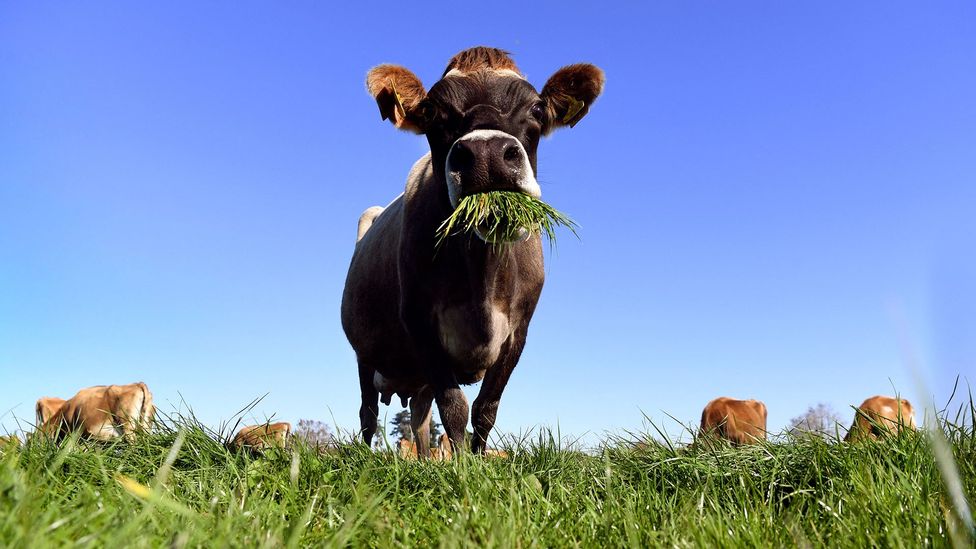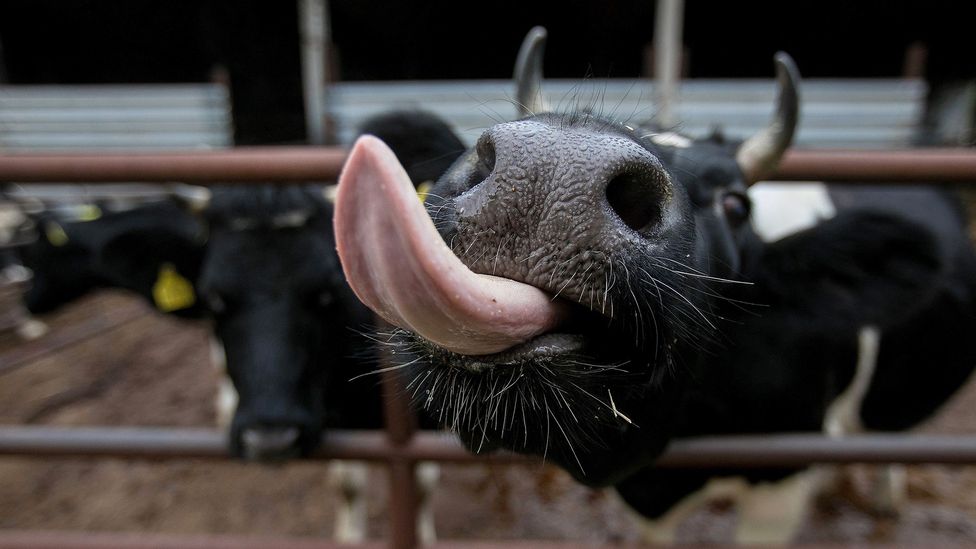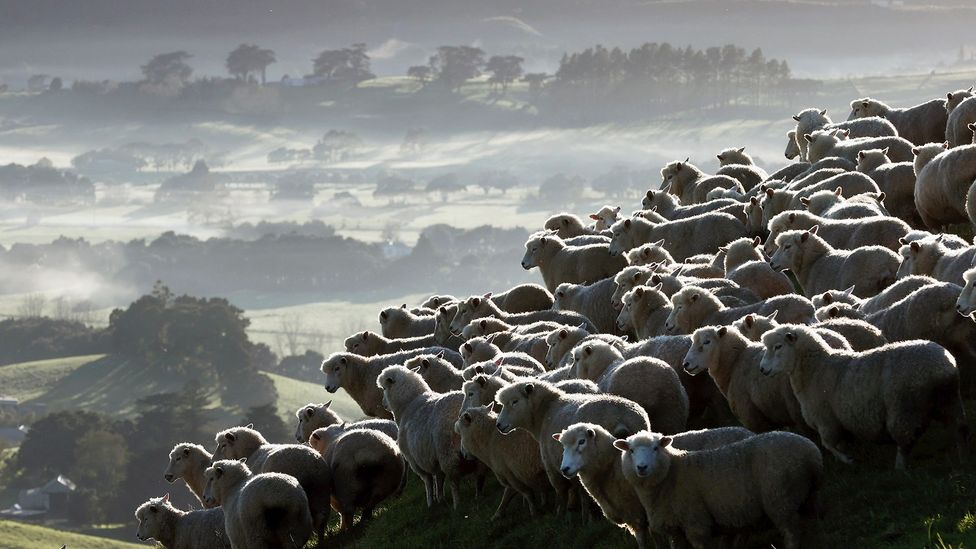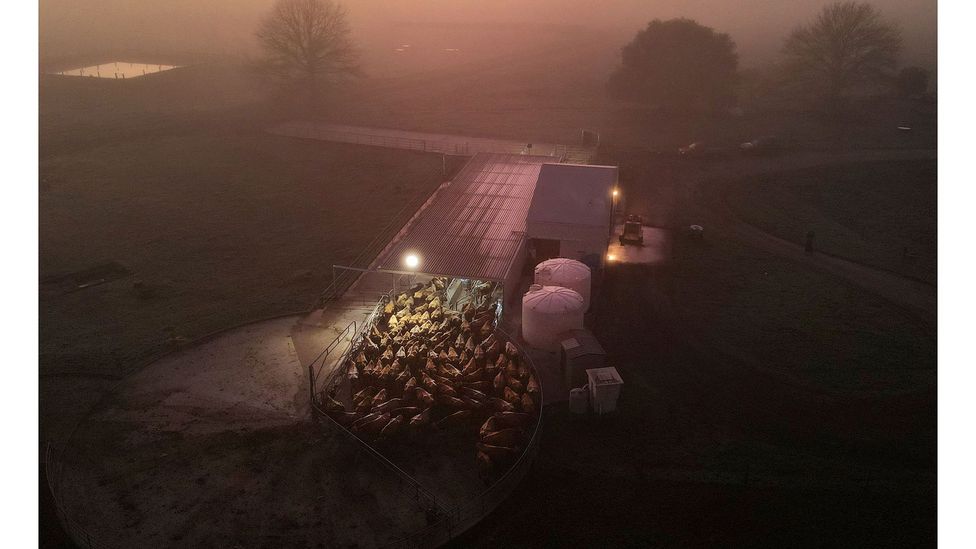New Zealand is home to 10 million cows and 26 million sheep. To reach its climate goals, the country must curb potent methane emissions from animal farming, using science and policy.
But the only thing cooking up here is a precise measurement of methane, a highly potent gas that has a global warming impact 84 times higher than carbon dioxide (CO2) over a 20-year period.
The bull’s breath, laced with gas from his digestive tract, is hoovered up by a fan at 40 litres (8.8 gallons) per second, and measured in this device known as a GreenFeed system.
Over a few minutes of snacking, the bull’s burps and breaths are analysed to build a picture of just how much methane his digestive system is churning out. Lorna McNaughton, senior scientist at agri-tech cooperative Livestock Improvement Corporation (LIC) in New Zealand, scrutinises the data on a computer monitor. Some bulls produce more methane, some less.
The bulls, aged between six and 15 months, are “like teenagers, getting up to all sorts of mischief”, says McNaughton. They’re enticed into the GreenFeed contraption six times a day with a tasty snack of Lucerne hay cubes: “lollies they get for doing the work,” she says. Their barn stay lasts around 40 days, so researchers can closely monitor food intake and weight gain alongside burps.
Since 2021, LIC and another cattle breeding cooperative, CRV Ambreed, have joined forces to measure the methane of 800 young bulls and counting. It’s the first step in breeding dairy cows that naturally produce less methane – one way New Zealand is hoping to curtail emissions of this potent, short-lived greenhouse gas.
New Zealand has an unusual emissions profile, thanks in part to its resident 10 million cattle and 26 million sheep. Almost half of the country’s emissions come from agriculture. Methane alone makes up 43% of total emissions, with most methane (more than 85%) coming from livestock.
Unlike carbon dioxide, which hangs around for centuries, most methane persists for only a decade or so. This means that tackling methane is a powerful lever: reducing methane emissions by 30% by 2030 globally, as per the Global Methane Pledge, could eliminate over 0.2C (0.36F) warming by 2050.
New Zealand is one of more than 100 countries signed up to the Global Methane Pledge. But while other nations focus on plugging leaks from oil fields and natural gas pipelines, New Zealand’s focus is on the methane brewed by microbes in the digestive tracts of farm animals and belched into the atmosphere. The country has long seen this as a niche where it can punch above its weight – and it will need to do so, if it hopes to reach its climate targets.
Its two-step target, established in 2019 legislation, seeks to reduce biogenic methane (from both animals and waste) by 10% on 2017 levels by 2030, and 24–47% by 2050. In turn, this goal is meant to be consistent with global efforts to keep heating below 1.5C, via the country’s international commitment under the Paris Agreement.
In 2022, New Zealand unveiled its strategy to curb greenhouse gases and transition to a low-emissions future in an emissions reduction plan. In the agriculture sector – considered an important player due to its substantial chunk of the total emissions pie – plans for a world-first emissions pricing scheme featured alongside boosting mitigation tech development.
But a change in government following October’s election has seen the demise of the pricing scheme and a shift in policy to focus on as-yet-unavailable gene editing technology. What will it take to curtail methane from livestock in a country with agriculture at its heart?

New Zealand is harnessing a range of scientific tools, including methane-blocking vaccines, inhibitors and selective breeding, to curb its farming emissions (Credit: Getty Images)
“People are attracted to this idea of a silver bullet. But it’s a variety of practices and technologies that are going to be needed,” says Sinead Leahy, principal science advisor at the New Zealand Agricultural Greenhouse Gas Research Centre (NZAGRC).
The NZAGRC has sought to cultivate this variety of solutions since 2009. It doesn’t employ research teams directly, but strategically funds external teams investigating new technologies like vaccines and methane inhibitors.
Since its inception, around NZ$90m (£44m/US$56m) has been invested in research, infrastructure and capability through the NZAGRC. A 2018 review acknowledged the research is “scientifically challenging”, and found a “shortfall in feasible and practical mitigation options”. Currently available approaches – mostly changing how operations are managed on-farm, like frequency of milking – would only result in a 10% emissions reduction at best, according to the review.
Five years on, that’s still largely true. New Zealand’s 2030 target, to reduce emissions by 10% on 2017 levels, is looking “challenging”, says Leahy. “There may be a limited set of technologies that will be available in time for the 2030 target,” she estimates. Leahy is more optimistic about the potential of emerging tech in the longer term. “We’re really looking more in that 2030 to 2040 bracket for when investment into science will hopefully start to pay dividends,” she says. In the meantime, she adds, most reductions are likely to come from farmers becoming more efficient, alongside land-use changes and reductions in the waste sector.
Methane makes up 43% of New Zealand’s total emissions
Methane inhibitors may be one of the technologies to make the grade in time. One is already on the market internationally: a Dutch-developed feed additive called Bovaer. The compound reduces dairy cow methane emissions by 30% – but only in feedlot animals where it can be added to every mouthful. This makes it tricky to implement in New Zealand’s pastoral grazing system where cattle are outdoors munching grass. “We need to figure out an effective way to make it work, and be economically viable, in our system,” Leahy says.
Another attractive tech solution, a methane-blocking vaccine, is much less likely to be ready by 2030. Considered a holy grail due to its potential to be long-lasting and applicable in pasture-based farming, a vaccine remains elusive despite more than a decade of research effort. “We don’t have any proof of concept,” says Leahy. “But no experiments to date have shown that it won’t work either, which is encouraging,” she adds. Scientists at AgResearch, a research institute in New Zealand, have achieved promising test tube results, but vaccination trials in sheep haven’t been successful yet.
One idea is likely to be in farmers’ climate toolbox sooner than either inhibitors or vaccines. Selective breeding with low-emitting bulls could reduce the methane outputs of the country’s dairy herd, which currently accounts for almost one-fifth of all of New Zealand’s emissions.
“We’re seeing 15 to 20% differences between low emitters and the average,” says McNaughton. “So I’m feeling quietly optimistic.”
Leahy agrees that the results appear promising, but notes there’s a lot more research and time needed to gather data. “There’s still a good bit of work to be done to verify the trait and make sure there are no adverse effects for breeding a low-emitting cow, for example on fertility,” she says.
Evidence from a US dairy cow herd suggests that low-methane cows might be smaller in stature with different gut bugs, but that their milk production and composition won’t be affected. Similarly, Irish cows that emit 15% less methane produce just as much milk for the same amount of feed, according to a study published this week.
At LIC, a similar investigation is underway with a new generation of daughters sired by the low-emitting bulls identified so far. The cows will be closely monitored for any adverse effects, such as reduced milk production.
By 2026, if no curveballs emerge, McNaughton expects that LIC and its competitor CRV will have a methane index for the bulls that sire 90% of New Zealand’s dairy herd through artificial insemination. This will mean that farmers can select bulls with lower methane profiles, among other desirable traits.

New Zealand is home to 10 million cattle and half of its national emissions come from agriculture (Credit: Getty Images)
Selective breeding of low-methane dairy cattle rests on a foundation of sheep. While sheep emit, on average, 13kg of methane every year, compared to 98kg for a dairy cow, starting with sheep was a logistical choice. “Sheep are much easier to handle,” says Suzanne Rowe, senior scientist at AgResearch, “and their gestation period is much shorter.” Fourteen years ago, Rowe and a team of AgResearch scientists wondered whether a sheep’s methane emission levels could be passed from one generation to the next. They gathered 1,000 sheep from across New Zealand and began to measure their gas outputs over 48 hours using a respiration chamber.
“It took years to get through the 1,000 animals,” says Rowe, explaining the painstaking process to refine measurement down to just one hour instead of 48. The “huge challenge” yielded three incredibly useful things: a flock of low-emitting sheep, a flock of high-emitting sheep, and a portable unit for fast methane measurement.
The two flocks were relocated to the same farm in the South Island. High emitters bred with other high emitters, and lows with lows. Every year, Rowe and her team measured the methane outputs of the new lambs. And every year, the low emitters got lower by about 1%. Today the difference between the high and low flocks is, on average, 18%. Plus, the reduction doesn’t appear to come at the cost of other desirable traits – in fact, changes that have emerged so far are positive. “[Low-emitter] sheep had more wool,” says Rowe. “We also found that they have a slightly different fatty acid profile in their milk and meat, and were leaner.”
Meanwhile, the portable methane chamber has enabled farmers across New Zealand to identify the low emitters in their own flocks as part of a ‘Cool Sheep’ programme. “We’ve been driving up and down the countryside, measuring sheep from different farms,” says Rowe, estimating that they have now measured 30,000 individuals. “The plan is to enable farmers to choose the low emitters within their own flocks,” Rowe explains. “That’s really important because it means that the animals they choose are already adjusted to that environment.”

New Zealand has found a way to breed flocks of lower methane-emitting sheep (Credit: Getty Images)
What impact will selective breeding have on New Zealand’s methane emissions? For sheep, Rowe estimates a decrease in methane emissions of around 0.5 to 1% per year. “Over time, that quickly becomes substantial,” she says. “The other benefit is that, other than the actual measurement of the animal, it’s low cost. And it’s permanent.” But the impact of selective breeding is also slow to emerge, as genes filter through a population over time rather than acting instantaneously.
In Canada, low-methane bull semen became commercially available earlier this year. Semex, the company behind the genetics, says adoption of the low-methane trait could reduce Canada’s dairy herd emissions 20–30% by 2050.
New Zealand’s numbers are more conservative. In 2021, modelling by the country’s Climate Change Commission suggested that low-methane breeding for sheep and beef cows would produce 4.5–7.5% reductions by 2050. For the dairy cattle herd, breeding is predicted to come online from 2030 and yield a 7.5–13.5% methane reduction by 2050.
Behind the incremental march of scientific efforts, the spectre of a price on agricultural emissions looms large. New Zealand’s first attempt at introducing an agricultural emissions levy dates back to 2003, when a ‘fart tax’ furore erupted. ‘Fart tax’ is a misnomer, says Leahy, as most gases are expelled out the front end: “about 75:25 nostrils to mouth”.
The proposed levy would have raised NZ$8.4m (£3.1m or US$4.9m) per year for research. Vehement opposition to the idea saw one MP drive a tractor up the steps of parliament, and another lead two cows around parliament grounds, with one depositing a steaming cowpat in front of the parliament.
Since then, the agriculture sector has lobbied hard to avoid being roped into New Zealand’s emissions trading scheme, making it an outlier industry that doesn’t pay a price for its climate pollution.

New Zealand’s Climate Change Commission has warned that the country is not on track to meet its long-term methane reduction targets (Credit: Getty Images)
In 2017, Jacinda Ardern, who had campaigned on a promise to bring farming into the ETS, unexpectedly became prime minister. The farming sector secured a deal with the government to co-design a separate pricing scheme in a partnership called ‘He waka eke noa‘ (named after a Māori proverb, meaning “we’re all in this together”). In advice delivered during the design process, New Zealand’s Climate Change Commission said that “a farm-level pricing system, supported by well-designed, well-thought-through policy” is an important tool for achieving the country’s climate targets.
In the final plan, announced in December 2022, the government would set different five-year prices for methane, nitrous oxide and carbon dioxide, with input from farming representatives and the Climate Change Commission. The scheme was meant to come into effect in 2025, but by mid-2023 the plan had fallen over. A new centre-right coalition is likely to see any potential pricing of cow burps pushed back to 2030.
Suzi Kerr, a New Zealand economist with expertise in emissions pricing policy, says the delay is “going to be really damaging when they have to hurry to catch up later.
“Hurrying to catch up is costly, it’s difficult,” she says.
According to Kerr, an agricultural pricing scheme wouldn’t just benefit the climate, it would also help New Zealand farmers by providing consistent market signals and a mechanism to reward them for their climate action.
“Farmers are in this invidious position of knowing what they should be doing from a global point of view, but facing really strong economic signals that are saying ‘produce more’ and don’t focus on mitigation. Pricing levels that playing field,” says Kerr.
We’re seeing 15 to 20% differences between low emitters and the average – Lorna McNaughton
Without a pricing scheme, will New Zealand be able to reach its methane reduction targets? “New Zealand’s history would suggest no,” says Kerr.
In 2021, emissions from the agriculture sector dipped by 1.5%, in part due to fewer sheep and cattle. But it’s a tiny blip after almost a decade of a stubborn plateau, and not necessarily enough to indicate a new trend, says Kerr. “Improvements in lowering emissions have been offset by increased levels of production,” she says. “Even if they’re beginning to fall in some places, they’re not falling nearly fast enough.”
In advice released this week, the Climate Change Commission warned that New Zealand is not on track to meet its overall emissions reduction targets. For methane, the commission writes: “Existing policies alone… would not result in adequate biogenic methane reductions to meet the 2030 target.”
In order to achieve a 10% methane reduction by 2030 and reach the longer-term 2050 target, the commission emphasised that agricultural emissions pricing from 2025 will be “key” and a “necessary tool”. New tech, diversifying land use, and increasing on-farm efficiency will also play a role in the 2030 target, according to the commission.
Breeding low-methane animals, along with the development of methane inhibitors and vaccines, will help New Zealand meet its long-term climate goals, the commission notes.
The analysis was conducted in October 2023, before the election resulted in a change of government and new policy direction. While the new climate change minister welcomed the advice and has affirmed the government is “steadfast” in its commitment to the Paris Agreement, several keystone climate policies are set to be discarded or delayed – like the agricultural pricing scheme. The shift has attracted criticism from environmentalists for relying on technological works-in-progress, rather than proven interventions to reduce agricultural emissions. It will be up to the new government whether they heed the commission’s advice.
If the country fails to meet its agreed emissions reduction targets under the Paris Agreement, it may need to spend billions of dollars on overseas carbon credits to offset its climate pollution, including the methane-laced breath of farm animals.
Leahy says reducing methane in line with the official targets will be “challenging”. But she remains optimistic. She used to give presentations and tell the audience that she wasn’t even sure it would be possible to reduce the methane brewed in an animal’s gut. “Fast forward to today, and yes, there is sheep breeding, yes, there are inhibitors, yes, there are some feeds. These are all coming. And hopefully more,” she says.















